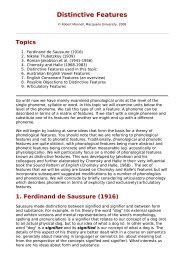Reversal of Short Front Vowel Raising in Australian English
Reversal of Short Front Vowel Raising in Australian English
Reversal of Short Front Vowel Raising in Australian English
You also want an ePaper? Increase the reach of your titles
YUMPU automatically turns print PDFs into web optimized ePapers that Google loves.
3.2. Comparison 2: 1965 and 1990<br />
This analysis from Cox [17] compared data from Bernard’s<br />
[2] 27 General <strong>Australian</strong> speak<strong>in</strong>g 15 year old male pupils<br />
from Sydney, recorded <strong>in</strong> the mid 1960s (1965 data) with data<br />
from 60 speakers matched for age and accent from Sydney’s<br />
north, recorded <strong>in</strong> the early 1990s (1990 data). This<br />
comparison represents a 25 year time span. Results for the<br />
monophthong comparison between the 1965 and 1990 data<br />
are represented <strong>in</strong> Figure 2 and, for the short front vowels,<br />
show significantly raised /ɪ/ and lowered and retracted /æ/ <strong>in</strong><br />
the 1990’s dataset (see [17] for details). Lower<strong>in</strong>g <strong>of</strong> /e/ was<br />
just beyond significance at p< 0.056 possibly <strong>in</strong>dicat<strong>in</strong>g the<br />
<strong>in</strong>cipient stage <strong>of</strong> change to this vowel. The 1965 data was<br />
only collected from males and we therefore have no citation<br />
form data from females before the 1990s.<br />
3.3. Comparison 3: 1990, ANDOSL and 2007.<br />
The current data (henceforth referred to as 2007 data) was<br />
compared with the 1990 data [3] and ANDOSL (1995) to<br />
determ<strong>in</strong>e the more recent changes to the short front vowels.<br />
Oneway ANOVA with post-hoc t-tests (Bonferroni alpha<br />
adjusted) was used to exam<strong>in</strong>e the relationship between the<br />
<strong>in</strong>dependent variables (three datasets) and the dependent<br />
variables (F1 and F2). These results are illustrated <strong>in</strong> Figures<br />
3 and 4. A ma<strong>in</strong> effect was found <strong>in</strong> F1 for each <strong>of</strong> the short<br />
front vowels <strong>in</strong>dicat<strong>in</strong>g height differences between the<br />
datasets (/ɪ/ F(2,69)=17.19 p
















